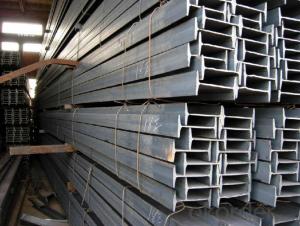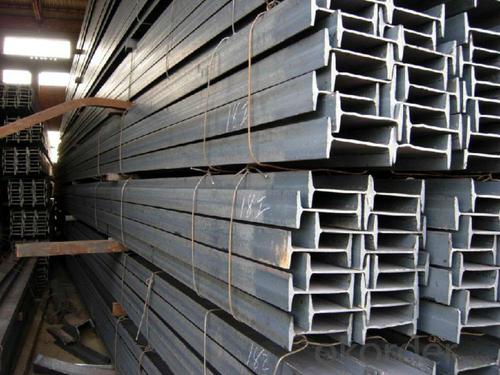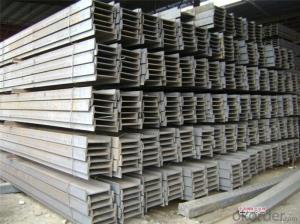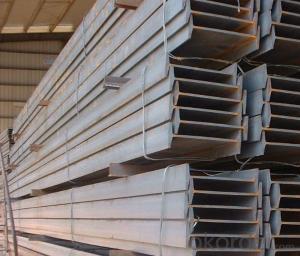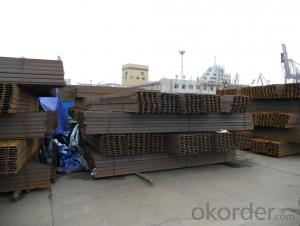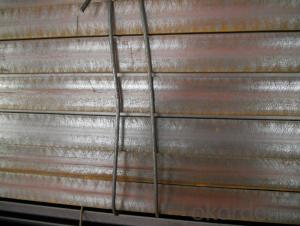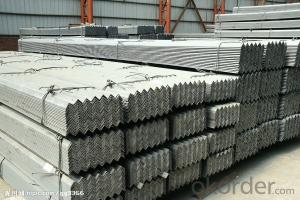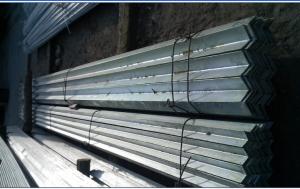Hot Rolled Steel I-Beams Source from China
- Loading Port:
- Tianjin
- Payment Terms:
- TT OR LC
- Min Order Qty:
- 25 m.t
- Supply Capability:
- 10000 m.t/month
OKorder Service Pledge
OKorder Financial Service
You Might Also Like
Specification
OKorder is offering high quality Hot Rolled Steel I-Beams at great prices with worldwide shipping. Our supplier is a world-class manufacturer of steel, with our products utilized the world over. OKorder annually supplies products to European, North American and Asian markets. We provide quotations within 24 hours of receiving an inquiry and guarantee competitive prices.
Product Applications:
IPE/IPEAA Beam Steel are widely used in various construction structures, bridges, autos, brackets, mechanisms and so on.
Product Advantages:
OKorder's Steel I-Beams are durable, strong, and resist corrosion.
Main Product Features:
· Premium quality
· Prompt delivery & seaworthy packing (30 days after receiving deposit)
· Corrosion resistance
· Can be recycled and reused
· Mill test certification
· Professional Service
· Competitive pricing
Product Specifications:
1. Product name: IPE/IPEAA Beam Steel
2. Standard: EN10025, GB Standard, ASTM, JIS etc.
3. Grade: Q235B, A36, S235JR, Q345, SS400 or other equivalent.
4. Length: 5.8M, 6M, 9M, 10M, 12M or as your requirements

Section | Standard Sectional Dimensions(mm) | ||||
h | b | s | t | Mass Kg/m | |
IPE80 | 80 | 46 | 3.80 | 5.20 | 6.00 |
IPE100 | 100 | 55 | 4.10 | 5.70 | 8.10 |
IPE120 | 120 | 64 | 4.80 | 6.30 | 10.40 |
IPE140 | 140 | 73 | 4.70 | 6.90 | 12.90 |
IPE160 | 160 | 82 | 5.00 | 7.40 | 15.80 |
IPE180 | 180 | 91 | 5.30 | 8.00 | 18.80 |
IPE200 | 200 | 100 | 5.60 | 8.50 | 22.40 |
IPE220 | 220 | 110 | 5.90 | 9.20 | 26.20 |
IPE240 | 240 | 120 | 6.20 | 9.80 | 30.70 |
IPE270 | 270 | 135 | 6.60 | 10.20 | 36.10 |
IPEAA80 | 80 | 46 | 3.20 | 4.20 | 4.95 |
IPEAA100 | 100 | 55 | 3.60 | 4.50 | 6.72 |
IPEAA120 | 120 | 64 | 3.80 | 4.80 | 8.36 |
IPEAA140 | 140 | 73 | 3.80 | 5.20 | 10.05 |
IPEAA160 | 160 | 82 | 4.00 | 5.60 | 12.31 |
IPEAA180 | 180 | 91 | 4.30 | 6.50 | 15.40 |
IPEAA200 | 200 | 100 | 4.50 | 6.70 | 17.95 |
5.Color marking: There will be color marking on both end of the bundle for the cargo delivered by bulk vessel. That makes it easily to distinguish at the destination port.
Tag mark: there will be tag mark tied up on the bundles. The information usually including supplier logo and name, product name, made in China, shipping marks and other information request by the customer.
If loading by container the marking is not needed, but we will prepare it as customer request.
6. Shipment: In containers or in bulk cargo
FAQ:
Q1: Why buy Materials & Equipment from OKorder.com?
A1: All products are carefully selected from China's most reliable manufacturing enterprises. Through its ISO certifications, OKorder.com adheres to the highest standards and a commitment to supply chain safety and customer satisfaction. We can guarantee the quality!
Q2: The products are invoicing on theoretical weight or on actual weight?
A2: We can do it in both manners, it’s according to buyer's requirement.
Q3: Can you offer the third part inspection certificates ?
A3: Yes, we can apply third part inspection before shipping, such as SGS, BV, etc .
Images:
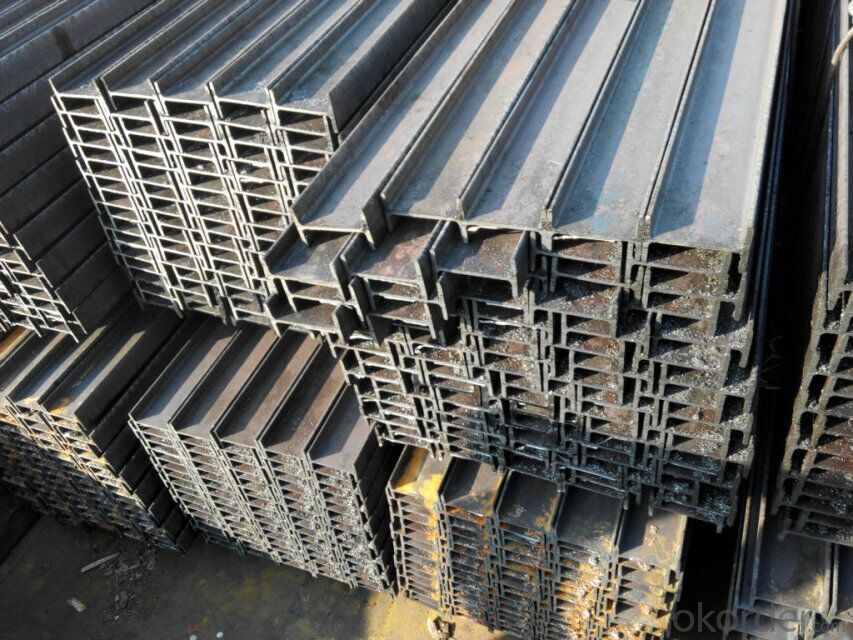
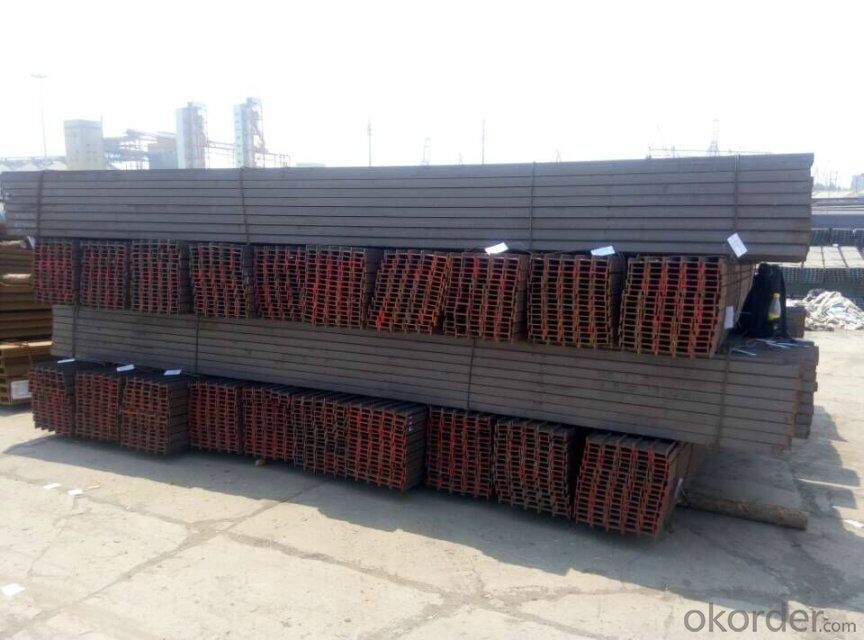
- Q: How do steel I-beams resist deflection?
- The structural design and material properties of steel I-beams enable them to resist deflection. The wide flanges and narrow web of an I-beam create a shape with a high moment of inertia, which prevents bending. This shape allows for the even distribution of loads across the cross-section of the beam, minimizing deflection. The flanges, positioned at the top and bottom of the beam, are where most of the bending stresses occur, while the web connects them, ensuring stability and resistance against twisting or buckling. Furthermore, steel possesses excellent strength and stiffness characteristics as a material. It has a high elastic modulus, indicating its ability to endure significant stress before permanent deformation. This quality enables I-beams to withstand heavy loads without deflecting. Additionally, steel exhibits a high yield strength, which is the point at which it begins to deform plastically. This feature allows I-beams to handle even greater loads before experiencing failure. To further enhance deflection resistance, I-beams can incorporate additional reinforcements like stiffeners or bracing. These reinforcements provide extra support and rigidity, effectively reducing deflection by increasing the overall stiffness of the beam. In conclusion, steel I-beams resist deflection due to their shape, which includes a high moment of inertia and even load distribution, as well as the inherent strength and stiffness properties of steel. By combining these factors, I-beams are capable of withstanding heavy loads while maintaining minimal deflection.
- Q: Can steel I-beams be customized or fabricated to specific lengths or dimensions?
- Indeed, it is possible to customize or fabricate steel I-beams to specific lengths or dimensions. Companies specializing in steel fabrication possess the necessary skills to cut, bend, and weld the beams in accordance with the desired specifications. This extensive range of customization options allows for the beams to be perfectly tailored to meet the specific requirements of any given project. Whether it be for construction purposes, infrastructure development, or any other application, steel I-beams can be precisely fabricated to ensure ideal performance and structural integrity.
- Q: Are steel I-beams subject to any specific building code requirements?
- Yes, steel I-beams are subject to specific building code requirements. Building codes outline the minimum standards and specifications for the design, construction, and use of structures, including the use of steel I-beams. These codes ensure the structural integrity, safety, and performance of buildings, and typically include provisions for the size, material quality, spacing, connections, and fire resistance of steel I-beams. Compliance with these requirements is necessary to obtain building permits and ensure the overall safety and quality of the structure.
- Q: What is the weight of a steel I-beam?
- The weight of a steel I-beam can vary depending on its dimensions and the specific type of steel used. Generally, the weight of a steel I-beam is calculated by multiplying its cross-sectional area by the density of steel. The cross-sectional area is determined by the height, width, and thickness of the beam. To provide a more specific answer, the weight of a steel I-beam can range from a few hundred pounds to several thousand pounds, depending on its size. For example, a 10-foot long I-beam with a height of 4 inches, width of 6 inches, and thickness of 0.25 inches may weigh around 31 pounds per foot, resulting in a total weight of approximately 310 pounds. It is important to note that these calculations are just estimates, and the actual weight of a steel I-beam should be confirmed with the manufacturer or through reference to engineering tables.
- Q: Are steel I-beams suitable for supporting rooftop HVAC units?
- Indeed, steel I-beams are perfectly appropriate for the purpose of supporting rooftop HVAC units. Renowned for their robustness and capacity to bear heavy loads, steel I-beams prove to be an optimal selection when it comes to sustaining substantial equipment such as rooftop HVAC units. They offer exceptional structural reinforcement, effectively enduring the weight and vibrations associated with HVAC units. Moreover, steel I-beams possess durability, resistance to corrosion, and the ability to withstand inclement weather conditions, thereby rendering them a dependable choice for providing long-term support.
- Q: How are steel I-beams used in roof framing?
- Steel I-beams are commonly used in roof framing to provide structural support and stability. They are typically installed horizontally across the top of the building's walls and act as load-bearing elements. The I-beams distribute the weight of the roof evenly, ensuring that it can withstand the forces of gravity, wind, and other external factors. Additionally, steel I-beams offer a high strength-to-weight ratio, making them an ideal choice for roof framing as they can support heavy loads while minimizing the overall weight of the structure.
- Q: Can steel I-beams be used in entertainment venues or theaters?
- Absolutely, without a doubt, steel I-beams are suitable for utilization in entertainment venues or theaters. In the realm of construction, steel I-beams are widely employed due to their robustness, longevity, and capacity to bear substantial loads. Within entertainment venues and theaters, these beams are often employed as foundational components, bolstering the roof, floors, and walls, thereby ensuring the overall stability and safety of the structure. Furthermore, steel I-beams can be utilized to establish elevated platforms and balconies, offering unobstructed views for the audience. The adaptability and ability of steel I-beams to span great distances render them an optimal choice for expansive, open areas, granting a multitude of design alternatives in entertainment venues and theaters.
- Q: How do steel I-beams perform in high-wind areas?
- Steel I-beams are highly regarded for their exceptional performance in high-wind areas. Due to their inherent strength and rigidity, steel I-beams are capable of withstanding the intense forces and pressures that are often exerted by strong winds. The structural design of I-beams, with their flanges and web, allows them to efficiently distribute and transfer these forces throughout the entire beam, ensuring the load is evenly distributed and minimizing the risk of structural failure. Furthermore, steel I-beams have a high strength-to-weight ratio, which means they can withstand high wind speeds without adding excessive weight to the overall structure. This advantage makes them an ideal choice for buildings in high-wind areas, as they can reliably resist wind loads while minimizing the need for additional support structures. In addition to their inherent resistance to wind forces, steel I-beams can also be further enhanced using various design techniques. Increasing the depth or thickness of the beam, adding additional flanges or webs, or incorporating diagonal bracing can all contribute to improving the beam's ability to withstand high winds. It is important to note that while steel I-beams are highly effective in high-wind areas, the overall performance of a structure will also depend on other factors such as the quality of the construction, the proper installation of the beams, and the overall building design. Therefore, it is crucial to consult with structural engineers and adhere to local building codes and regulations to ensure the safe and efficient use of steel I-beams in high-wind areas.
- Q: Are steel I-beams compatible with other building materials?
- Indeed, steel I-beams prove to be compatible with various building materials. Being a versatile construction material, steel commonly combines with other materials in construction projects. Easy integration is possible between steel I-beams and materials like concrete, wood, glass, and even other metals. These beams frequently function as load-bearing structural elements in buildings, providing support for other materials and enabling a wide range of design possibilities. Moreover, architects and engineers favor steel I-beams due to their flexibility and ease of customization according to specific project requirements. Consequently, steel I-beams represent a flexible and dependable option for construction projects, offering compatibility with diverse building materials.
- Q: What are the different surface treatments available for steel I-beams?
- There are several different surface treatments available for steel I-beams, each serving a specific purpose and providing unique benefits. 1. Galvanizing: Galvanizing is a commonly used surface treatment for steel I-beams. It involves coating the surface of the beam with a layer of zinc through a process called hot-dip galvanization. This treatment provides excellent corrosion resistance, protecting the steel from rust and other environmental factors. Galvanized steel I-beams are commonly used in outdoor or high-humidity environments. 2. Painting: Painting is another surface treatment option for steel I-beams. It involves applying a layer of paint to the surface of the beam, which not only enhances its appearance but also provides a protective barrier against corrosion. Painting can be done using various types of paints, including epoxy, polyurethane, or enamel paints, depending on the specific requirements of the application. 3. Powder Coating: Powder coating is a dry finishing process that involves applying a powdered polymer coating to the surface of the steel I-beam. The powder is electrostatically sprayed onto the beam and then cured under heat, resulting in a smooth and durable coating. Powder coating provides excellent resistance to corrosion, chemicals, and UV rays, making it suitable for both indoor and outdoor applications. 4. Shot Blasting: Shot blasting is a surface treatment method that involves propelling small metallic or non-metallic particles, called shot, at high velocity onto the surface of the steel I-beam. This process removes scale, rust, and other contaminants, leaving behind a clean and roughened surface. Shot blasting prepares the surface for further treatments such as painting or galvanizing, ensuring proper adhesion and longevity of the coating. 5. Phosphating: Phosphating is a chemical surface treatment method that involves applying a layer of phosphate coating to the surface of the steel I-beam. This treatment enhances the adhesion of subsequent coatings, such as paints or primers, and provides temporary corrosion resistance during storage and transportation. Phosphating can also improve the overall durability and wear resistance of the steel. It is important to consider the specific requirements and environmental conditions of the application when choosing the appropriate surface treatment for steel I-beams. Consulting with professionals or experts in the field can help determine the most suitable treatment option for a particular project.
Send your message to us
Hot Rolled Steel I-Beams Source from China
- Loading Port:
- Tianjin
- Payment Terms:
- TT OR LC
- Min Order Qty:
- 25 m.t
- Supply Capability:
- 10000 m.t/month
OKorder Service Pledge
OKorder Financial Service
Similar products
Hot products
Hot Searches
Related keywords
